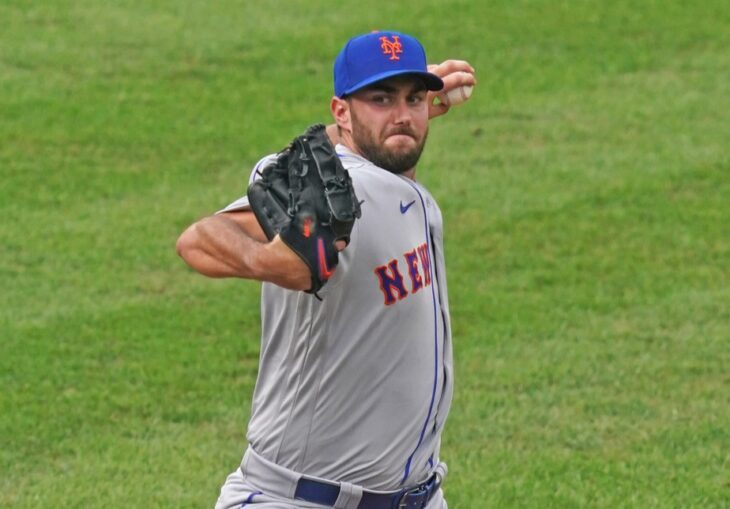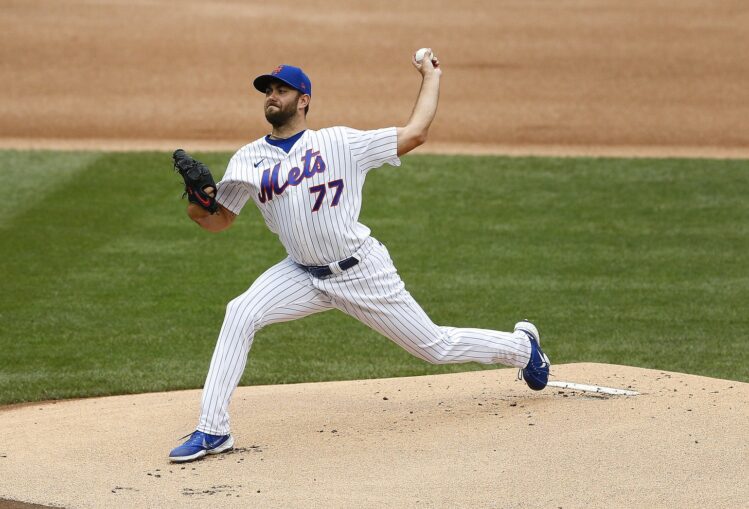David Peterson Can Take Step Forward With Improved Changeup

While receiving quality performances from the starting rotation was a major issue for the New York Mets last season, aside from ace Jacob deGrom, of course, they were pleasantly surprised to watch one of their top young hurlers arrive on the scene and enjoy one of the top statistical showings of his career.
After pitcher Marcus Stroman suffered a torn calf and ultimately opted out of the 2020 campaign, the Mets were left with a massive hole to fill in their rotation, especially since teammate Noah Syndergaard was also sidelined for the entire season with a torn ulnar collateral ligament in his elbow. With both Stroman and Syndergaard out for the season, the team needed someone to step up in a massive way, forcing them to call upon rookie David Peterson and the youngster certainly didn’t disappoint.
Even though Peterson had never played above double-A Binghamton heading into last season, the lack of a minor league season opened the door for him to showcase his skills at the highest level of competition, allowing him to prove he belongs in the majors. Despite experiencing some shoulder fatigue, which earned him a brief trip to the injured list, the 25-year-old still enjoyed plenty of success and also served as one of the top rookie pitchers across the major leagues.
Over his 49 2/3 innings in 2020, the left-hander produced a 3.44 ERA, 81 ERA- 4.52 FIP, 5.11 xFIP, 1.21 WHIP, .202 AVG, .233 BABIP, 19.5% strikeout rate, 26.1% whiff rate, 24.1% chase rate, 11.7% walk rate, 19.3% LD rate, 44.4% GB rate, 36.3% FB rate, 33.3% hard-hit rate and a 0.5 fWAR rating.
In comparison to other rookie hurlers, Peterson finished tied for the ninth-highest fWAR rating and recorded the 12th-lowest BABIP, the 13th-lowest LD rate, the 15th-lowest ERA, the 16th-lowest ERA- and the 20th-lowest FIP among all qualified rookie starters, according to FanGraphs.com.

Considering the former first-round pick was projected to begin the 2020 campaign at triple-A Syracuse, the Mets have to be extremely pleased with his rookie performance and they’re hopeful he’ll at least replicate these promising results in 2021. Having said that, it’d be even more impressive if he’s able to take a positive step forward with his development during his second season in the majors.
So how can Peterson take his game up to another level this season?
Well, it’ll be crucial for him to reduce his walk totals while also increasing his strikeout totals at the same time. Since the young lefty induced a ground ball rate of at least 52.0% in each of his four minor-league seasons, it’ll also be very important for him to significantly improve off his sub-50.0% GB rate from last season, which could help him lower his concerning fly ball rate as well.
But in order to accomplish these feats, Peterson must continue improving his five-pitch repertoire, particularly his mid-80s changeup. Dominating opposing batters with both his low-90s fastball and low-80s slider, the 6′ 6″ youngster struggled at times with his primary offspeed weapon and will need to perform more effectively with it to remain in the starting rotation moving forward.
In total, the former top prospect utilized his changeup 18.7% of the time in 2020 (third-most among all of his pitches), allowing a .333 AVG, .307 xAVG, .556 SLG, .534 xSLG, .407 wOBA, .392 xwOBA, 31.3% hard-hit rate along with a pair of home runs against it. Additionally, it also generated the lowest ground ball rate (40.6%) and the third-lowest strikeout rate (10.0%) among all of his pitches.
Despite these troubling metrics, Peterson’s changeup is still considered a plus pitch, as it averaged 3.5 inches more break than similar changeups at his velocity, which was tied for ninth-most among all qualified pitchers. Adding to its stellar side-to-side movements, it also finished tied for the second-highest active spin percentage (99.0%) last season.
While his offspeed pitch features plenty of horizontal movement, the Oregon standout still needs to work on its vertical movements, which largely prevented him from unlocking its full potential. At an average of just 31.2 inches of drop, his changeup was located in the middle of the strike zone far too often and it allowed hitters to generate plenty of damage against it.
But with Peterson making adjustments to his changeup as the season progressed, its vertical movements fluctuated throughout the summer, as it peaked at 29.0 inches of drop and dipped down as far as 33.0 inches of drop.
Here’s how Peterson’s changeup changed its vertical movements during the 2020 campaign:

Source: BaseballSavant.com
As for how his changeup’s vertical movements affected its location, it was primarily located in the middle section of the strike zone when it ranged between 30-32 inches of drop. But when it dropped down to 32-33 inches of drop, the towering lefty located his third offering much more effectively at the bottom of the strike zone.
Here’s where Peterson located his changeup from Jul. 28 to Aug. 8:

Source: FanGraphs.com
In comparison, here’s where it was located from Aug. 13 to Sep. 7:

Source: FanGraphs.com
Based on these charts, it’s clear Peterson is more effective when his changeup is averaging closer to 33.0 inches of drop, meaning that’s exactly what he needs to aim for this season. Since he’s already proven to be capable of hitting that mark, doing so consistently over a full season certainly doesn’t seem unattainable for him at this point, although that doesn’t mean it’ll be an easy process either.
Combining its stellar horizontal movements with an increase in vertical movement, the California native would likely be able to induce a lot more ground balls along with an improved amount of swings and misses if he can make this pivotal adjustment to his changeup. As a result, this would also allow the former Duck to reduce both his fly ball rate and walk rate, making him a more rounded pitcher.
With all three minor league options remaining, there’s no guarantee Peterson will break camp with the Mets on Opening Day, however, it seems the final spot in the rotation is his to lose right now. That being said, an open spot will probably need to be created once Syndergaard is ready to return from his Tommy John surgery, which could push the soft-throwing lefty to the bullpen or down to the minors.
Unless New York decides to roll with a six-man rotation through the second half of the season, which is possible, odds are Peterson will likely finish the 2021 campaign as a reliever. But if someone requires a stint on the IL, then there’s a very good chance he’d be utilized as an injury replacement, allowing him to remain as a starter for the time being.
Since Syndergaard and Stroman are both slated to hit free agency next offseason, it’s possible neither of them could return in 2022, meaning another strong showing from Peterson would undoubtedly secure his spot in the rotation for many seasons to come.

The post David Peterson Can Take Step Forward With Improved Changeup first appeared on Metsmerized Online.

